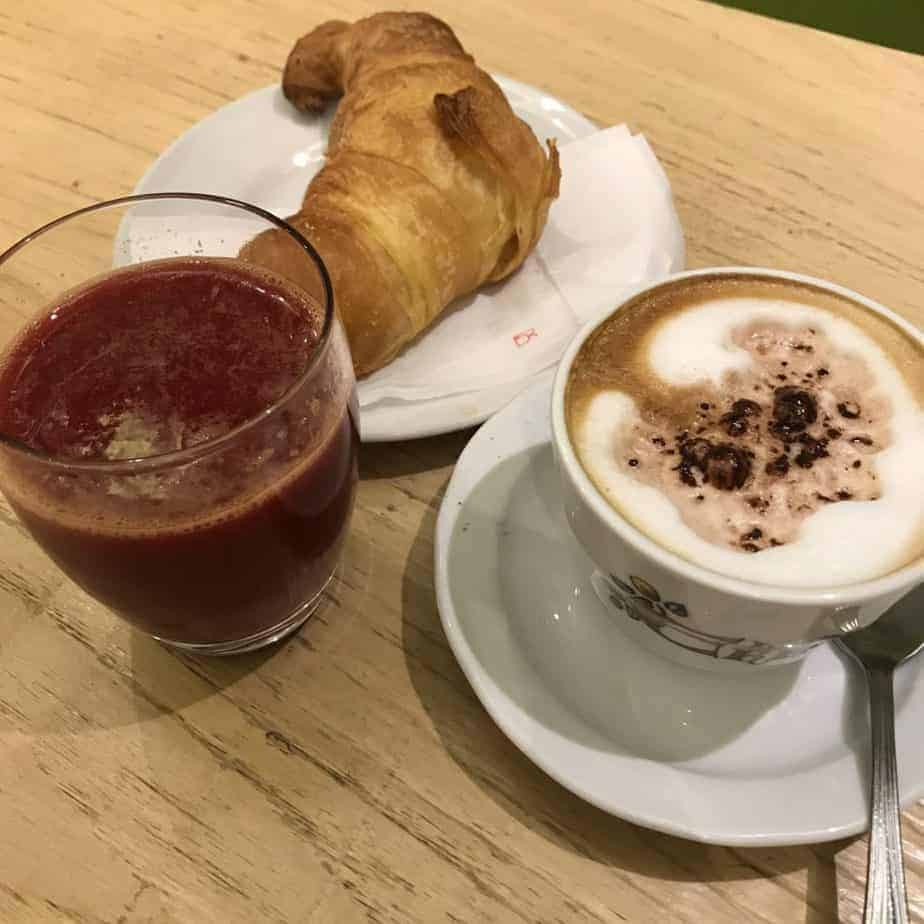Traveling to Italy? Enjoy the world-renowned coffee culture like a pro. Find out how to order coffee in Italian with this guide!
Most travelers know that Italian coffee is world-renowned. I still remember my first ever Italian cappuccino. It was made by a waiter at my hotel in Tuscany so my expectations weren’t very high. Amazingly, it was still one of the best cappuccinos I had ever had up to that point. Smooth but strong espresso with velvety soft foamed milk. Delicious, especially when paired with a Nutella croissant. When I went to a cafe, however, I discovered that there are unspoken rules and etiquette when it comes to how you order coffee in Italy.
Coffee culture in Italy is nothing like coffee culture in the United States. Here, we order massive coffees loaded with flavorings, sugar, and caffeine. You’d never be able to order a “quad venti white mocha frappuccino, one pump of vanilla, no whip” in Italy. And forget ordering a latte – if you do, you would likely get a very confused look and a glass of milk, since “latte” literally translates to “milk”!
Italian coffee culture is filled with unspoken rules, nuance, and a little bit of chaos. Ordering coffee is a bit like driving in Italy: a bit intimidating at first … but once you get the hang of it, really satisfying and quite easy.
Trying to blend in like a local? Order your coffee like a local. Find out how to order coffee in Italy – including key Italian phrases! – with this guide.
Where do you order coffee at?
When you go to a caffe in Italy, you have a choice to enjoy your order at the bar or while seated. It is not customary to order for take-away.
For bar service…
… pay attention to what other customers are doing. Larger caffè’s will likely have the cashiers and the baristas separate. In this case, order what you want – everything you want – with the cashier. They will likely hand you any pastries or non-coffee drinks you’ve ordered at the register. Take those items, along with your receipt, over to the bar counter. When asked what you ordered, state the order and show them your receipt.
If it’s a smaller caffè, your barista will likely also be your cashier. You’ll often pay after you finish and are ready to leave.
Voila! Enjoy your cappuccino or caffè at the counter, and watch the buzz of Italians enjoying their morning cornetto and cappuccino.
For a sit down experience…
… it is often typical for you to seat yourself. A waiter will come over and take your order. When you’re finished with your meal, you may pay at the table or you may pay at the bar. Ask your waiter to clarify.
Why is it important to distinguish between the two experiences? Because they have different costs!
Dining at the bar will often be about half the price of seated service. Italians almost always enjoy their caffè at the bar or at the nearby stand-up tables. If you’re on a budget, ordering at the bar is the way to go.
What coffee should you order?
Well, Italian breakfast (or colazione) is typically small and sweet. They often enjoy cappuccinos with a sweet pastry. Many more Americanized restaurants will have American-esque options (eggs and cheese, for instance), but it’s not traditional.
Well, my motto is when in Rome! So I like to keep it authentic, and I like to try and order in Italian whenever possible.
Drink Options in Italy
It doesn’t matter if you love to order lattes at Starbucks – don’t order a latte in Italy! If you do, you’ll get a confused look… latte literally means milk.
Are you wondering how to order coffee with milk in Italy? Check out the options below – there are a few options in Italy.
- un caffè. This is just an espresso!
- un cappuccino. Espresso with some stiff foamed milk. But be warned – it is not traditionally ordered after noon. If you want to fit in, drink this just in the morning hours.
- un caffè macchiato. This is a little milk with some coffee … kind of like a flat white.
- un latte macchiato. This is like a latte at Starbucks! If you want to order coffee with milk, this may be the best way to do so.
- un tè freddo/caldo. Tea! Freddo means cold, caldo means hot. I mix these words up for some reason, so one way to remember the distinction is “freddo” sounds like “freezing”.
- un’acqua naturala/gassata. Flat water or sparkling water. It’s important to specify, especially if you don’t like sparkling water. And remember, water almost always costs extra! If you don’t want to pay for flat water, carry a water bottle.
- una spremuta d’arancia. Fresh-squeezed orange juice. I had a glass of blood orange juice in Montepulciano recently and it was A-MAZ-ING. I watched the barista cut the oranges, drop them in a juicer, and pour the juice into my glass. Yum!

Food Options at Caffes
Now for food! Like I said, Italian breakfast is often sweet. My go-to was a cornetto, aka a croissant. You can’t beat a traditional buttery croissant, but many Italians like to order a cornetto alla crema (croissant with cream), cornetto ai cioccolato (croissant with chocolate), or cornetto con marmellata (croissant with marmalade).
If you want something with a little more substance, a macedonia (or a fruit salad) is a great option. Below I have un cappuccino, una macedonia, e un cornetto alla crema.

If you’re visiting a caffè after the breakfast hours, you may be able to order a croissant with meat and/or cheese, a small sandwich (un tramezzino), a panino, or even pasta or pizza. But remember, Italians don’t drink cappuccinos after noon!
Don’t forget dessert pastries! A cappuccino is wonderful with tiramisu or cannoli 🙂
… if you can’t tell, I pretty much lived off of cappuccino and carbs while I was in Italy. #noregrets
How to order coffee in Italian
Maybe I’m weird, but I love trying to immerse myself in the culture when I’m abroad. No, I don’t try and learn every language for every country I visit (sorry, Czech and Hungarian – I can exist without learning more than “hello” and “thank you”) – but for countries that I adore, I think it’s only fair to try and learn something.
So, if you’re like me, this is how you can order your morning coffee in Italian!
Of course, start your communication with a greeting. Buongiorno is always polite and appreciated!
When you’re ready to order, don’t just say what you want – it’s more polite to start with vorrei (“I would like”…). For instance…
… Vorrei un cappuccino e un cornetto (I would like a cappuccino and a croissant).
They may respond with desidera altro? (Do you want anything else?)
A response of basta cosi means “that’s enough”. If it isn’t enough, respond with “si, grazie” and anything else you’d like. Feel free to use my guide above for some assistance! And if you’re stuck on the specific word, you may always say questo (that) while pointing at whatever tasty treat you would like.
After you’re done ordering, just ask quanto è to get your final price. Pay the total listed on your receipt (scontrino or ricevuta), receive your change (il resto), and depart with a polite greeting (grazie e buona giornata, arrivederci!)
And like that, you’ve just ordered an entire meal in italiano!




